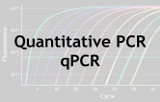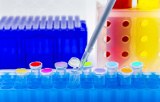
Quantitative PCR - qPCR
Quantitative PCR or real-time qPCR is a particular method of polymerase chain reaction to measure the initial amount of DNA. In fact, quantitative PCR measures the number of amplicons (DNA portion defined by a pair of primers).
It enables continuous monitoring ("in real time") of the PCR amplification process by detecting the fluorescence emitted by the neo-formed PCR products.
The profile of a conventional quantitative PCR reaction can be broken down into 3 steps:
- A first step known as background noise: the amount of amplified fragment is insufficient to generate a fluorescent signal greater than the background noise (and therefore the fluorescence generated).
- A second step of exponential phase of growth: the quantity of amplified fragment generates a fluorescent signal higher than the detection threshold of the apparatus, and then the number of amplified products doubles on each cycle. In logarithmic coordinates, this phase is represented by a line.
- A final stage of the plateau phase: certain components of the reaction (and in particular the number of available Taq molecules) become limiting. The system no longer allows exponential amplification.
The detection can be carried out using SYBR green, a fluorescent organic compound which binds to nucleic acids, or probes, Taqman or FRET.


